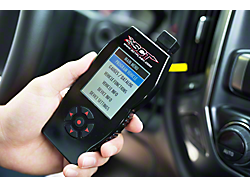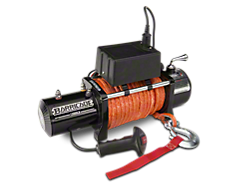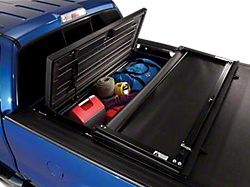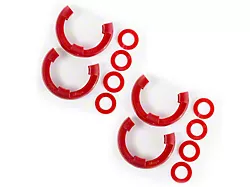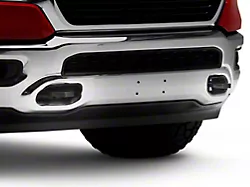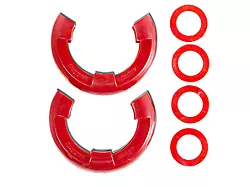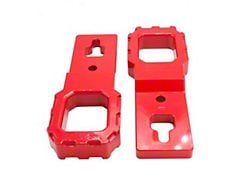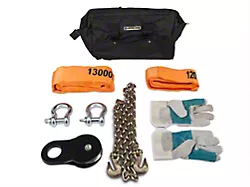Silverado 1500: Recommended Recovery Gear and Their Purpose
Winches are probably the first item that popped into your head when you thought of recovery. While winches are an important recovery tool, there’s other valuable gear you can purchase at a much cheaper price.
Besides, winches may not always be suitable for recovery. Here’s a list of essential recovery gear and their functions to help your Silverado recover from a sticky situation.
- Hi-lift jack: Allows you to change your tires in case you get a flat on the trail.
- Shovel: Digs your tires out of the dirt or snow in case your Silverado ever gets stuck.
- Traction boards: Provides tire traction in slick or thick muddy conditions.
- Tire repair kit: Allows you to patch small holes in tires.
- Tree trunk strap: Protects tree bark and recovery rope from damage.
- Leather gloves: Protects hands from abrasions when dealing with ropes, straps, or winch cable. Always recommended for safe recovery.
- Recovery strap: Enables other vehicles to pull your Silverado out of the mud or snow.
- Snatch Block: Doubles winch capacity and allows you to offset angled winch recoveries.
- D-ring: Serves as a mount for tow cables or straps.
Tips For Safe Recovery
- Whenever crossing through rough or muddy terrain, try and keep momentum going so your tires can don’t get bogged down before losing traction.
- Consider deflating tires before driving through mud or over shallow rocks so your tires can gain more traction.
- If your tires are stuck and spinning, use your shovel to dig out any mud or snow caught underneath your tires.
- Consider backing up onto a tread track to gain traction and attempt a different line of approach. The ground behind you will also be more packed and give you more traction.
- Always carry gloves when winching or using a recovery strap to protect your hands from abrasions.
- When winching, make sure the line is properly stretched and isn’t degraded.
- Follow manufacturers instructions when winching and be sure to clear the area of any immediate passengers in case the line snaps.
- If using an electric winch, be sure to allow proper time for the motor to cool so it doesn't overheat.
- Be sure to properly anchor any winches or recovery straps so they don’t snap or damage your Silverado in the process.
- Always use a tree trunk strap when using a recovery rope so it doesn't fray in the process.
- Be sure to only use recovery rope or snatches that are weighted to your Silverado’s capacity. A snatch block pulley helps add weight capacity to your rope, so be sure to have one on hand if you buy a cheap recovery rope.
- Call for help and be patient.
What Does a Snatch Block Do?
Your Silverado’s winch may only able to tow up to a certain capacity, especially for cheaper electric winches. Beyond this, sometimes you can't always pull off a straight line recovery if you don't have an anchor point available directly ahead. Snatch blocks resolve these problems by doubling winch capacity in double-line pulls and allowing you to offset anchor points at different angles.
A snatch block is simply a pulley block with a side plate that snaps over the winch cable. If your winch capacity is not enough to pull your vehicle or another vehicle out of the muck, you can use a snatch block to execute a double-line pull.
The snatch block accomplishes this by rerouting the winch cable from the anchor point back toward the winch motor itself in a straight line recovery, alleviating stress off the motor. If pulling another vehicle, the snatch block would be attached to the other vehicle and would reroute the cable from the vehicle to the anchor point, thereby relieving stress off of your Silverado. While the double-line pull doubles winching power, it also decreases cable speed.
If you can’t complete a straight line recovery, you can use your snatch block to create a second anchor point in the opposite direction of similar distance and radius to your vehicle.
Most people commonly use a choke chain to attach the block to the second anchor point. Once both angles are offset, you would then use the tension of the opposing anchor points to pull the snatch block directly in front of the vehicle to retain a straight line recovery.
Snatch blocks perform three functions:
- Doubling winch capacity on double-line pulls
- Adjusting for angled, single-line pulls
- Reducing winch stress
That’s why it’s crucial to carry around a snatch block in your toolbox. Without it, your winch system is very limited in its application.
Recovery Snatches or Ropes? What’s Better for my Silverado 1500?
Determining the value of a recovery snatch or rope will depend on the weight of your vehicle and the amount of stretch required from your recovery line.
Both have their advantages and they are generally weighted to tow at high capacity. Recovery ropes may fray, but they are thicker and typically last longer than recovery snatches. Recovery snatches will generally lose their strength after a few uses.
Tow ropes are generally rated to only stretch about 2%, while kinetic ropes and snatches can stretch upwards of 20%. That’s why it’s important to hook up kinetic ropes to a reliable anchor point. If the anchor point does break, or the rope comes loose, it could have a deadly ricochet. Generally speaking, kinetic snatches and ropes are rated to tow greater capacity than tow ropes.
Understanding D-Ring Recovery Points for your Silverado 1500
D-rings are essentially tie down points for towing operation. In most cases, installing a D-ring is simple. Just slide it into the hitch receiver of your truck and insert the hitch pin into the receiver clip. Of course, there are other spots in your frame that can serve as better recovery points for d-rings than standard mounts. These may be pre-installed on some off-roading bumpers or may require mechanical work on your end.
While many bumpers come with standard D-ring mounts, they’re not necessarily designed to serve as a strong recovery point. Depending on the weight of the vehicle and the weld of the mount, D-ring recovery points may only be able to handle up to a certain weight and can actually be a dangerous recovery point if not properly understood.
In general, a standard mounted D-ring should not be used for vehicle recovery. They work perfectly for light winching with kinetic straps and non-recovery towing, but most D-ring mounts are not rated to handle high capacity vehicle recovery.
Steel welded mounts will typically hold up stronger as a recovery point, but it’s essential to consult your bumper’s manufacturer to see what your D-ring recovery mounts are rated to handle.
Many off-road bumpers come with standard D-ring mounts directly on the bumper frame. But it’s ideal to install additional D-ring shackles directly onto the frame where it can handle high capacities.
Generally, a D-ring attached to a hitch receiver should serve as the best recovery point for winches and towing. Of course, many people make the mistake of hitching their recovery straps to improper D-ring mounts, thereby creating a massive safety hazard.
Shop All Truck Winches & Accessories
Fitment Includes
- 1999, 2000, 2001, 2002, 2003, 2004, 2005, 2006, 2007, 2008, 2009, 2010, 2011, 2012, 2013, 2014, 2015, 2016, 2017, 2018, 2019, 2020, 2021, 2022, 2023 and 2024 Silverados
- LT Z71, LTZ, Z71, LTZ Z71, WT, Work Truck, XFE, Hybrid, Lingenfelter Reaper, Custom, Special Ops Edition, High Country, LS, LT Silverados
- Engines: 4.3L Vortec V6, 4.8L Vortec V8, 5.3L Vortec V8, 5.3L Flex-Fuel Vortec V8, 6.0L VVT Vortec V8, 6.2L VVT Vortec V8, 4.3L EcoTec3 V6, 5.3L EcoTec3 V8, 6.2L EcoTec3 V8 Silverados
*Please see Silverado parts pages for any exceptions.

